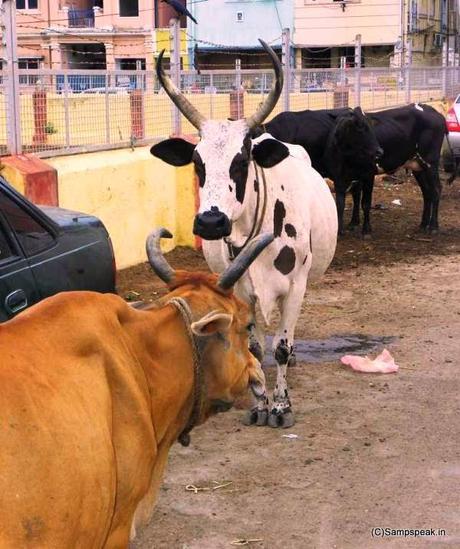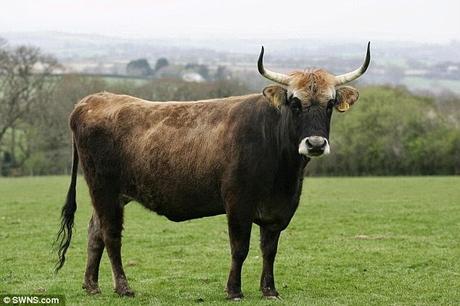 milch cow - cattle that are reared
for their milk. In Triplicane, the land
of Sri Krishna, cattle are aplenty – freely roaming on the streets. Cows are timid and frightening at times;
while buffaloes move slowly unfazed by the traffic around. This particular cow somehow impresses me – at
the same time, its horn do send a message of threat.
The aurochs, also urus (Bos
primigenius), is an extinct type of large wild cattle that inhabited Europe,
Asia and North Africa. It is the ancestor of domestic cattle. The species
survived in Europe until the last recorded aurochs died in the Jaktorów Forest,
Poland in 1627. During the Neolithic
Revolution, which occurred during the early Holocene, there were at least two
aurochs domestication events: one related to the Indian subspecies, leading to
zebu cattle; the other one related to the Eurasian subspecies, leading to
taurine cattle. A couple of months
back read an interesting article in MailOnline on a farmer being forced to
get rid of Hitler's Nazi cows because
ultra-aggressive breed tried to kill staff.
Farmer Derek Gow imported 13 'Heck'
cattle from Belgium to Lifton, Devon.
Derek Gow, runs Upcott Grange Farm in Lifton, Devon – the imported Auroch cows are known as 'Nazi cows'. The once-extinct Aurochs were brought back
to life by Adolf Hitler's scientists in the 1930s after officially dying out
4,000 years ago.
The half-tonne cattle died out in
Britain 4,000 years ago but remained widespread across much of Europe until the
1600s. However, they were finally wiped
out in 1627 after they were hunted to extinction for their horns, hide and
meat. They were saved in the early 1930s when Hitler wanted to recreate the
breed to evoke the power of the 'runes, folklore and legends of the Germanic
peoples'. Heinz and Lutz Heck found their descendants in a cattle from the
Scottish Highlands, Corsica and the French Camargue, as well as Spanish
fighting bulls. They then identified the particular Auroch gene, which they
were able to use to bring them back from the 'dead'. The cows were later
transported to game parks in Schorfheide near Berlin, and the Neander Valley in
Dusseldorf. Hitler saw the 'super cows'
as a symbol of German and Aryan might and tasked leading geneticists, brothers
Heinz and Lutz Heck, to bring the Aurochs 'back into existence'.
The Hecks' programme at zoos in Berlin
and Munich was so successful that the new Aurochs flourished and were used in
propaganda material during the Second World War. They arrived in Britain for the first time in
2009 when farmer Derek Gow imported 13 'Heck' cattle from Belgium to his Upcott
Grange Farm in Lifton, Devon. It was the
first time the creatures had set foot on British soil since the Bronze Age. Now, Gow has been forced to get rid of seven
of the cows as he could not handle their 'incredibly aggressive' nature. He offered to give them back to reserve from
which they came, but they didn't want them so they have now been sent to an
abattoir.
He said: 'The ones we had to get rid of
would just attack you any chance they could. They would try to kill anyone.
Dealing with that was not a lot of fun at all. 'I have worked with a range of
different animals from bison to deer and I have never come across anything like
these. 'They are by far and away the most aggressive animals I have ever worked
with. Mr Gow said: 'The Aurochs were
wild bulls. Julius Caesar recorded them as being bulls as big as elephants. 'Young
men hunted these bulls as preparation for battle and leadership in war, but
also to obtain these huge 6ft-wide horns that the bulls had as drinking vessels
and war horns. They were huge trophies.'
milch cow - cattle that are reared
for their milk. In Triplicane, the land
of Sri Krishna, cattle are aplenty – freely roaming on the streets. Cows are timid and frightening at times;
while buffaloes move slowly unfazed by the traffic around. This particular cow somehow impresses me – at
the same time, its horn do send a message of threat.
The aurochs, also urus (Bos
primigenius), is an extinct type of large wild cattle that inhabited Europe,
Asia and North Africa. It is the ancestor of domestic cattle. The species
survived in Europe until the last recorded aurochs died in the Jaktorów Forest,
Poland in 1627. During the Neolithic
Revolution, which occurred during the early Holocene, there were at least two
aurochs domestication events: one related to the Indian subspecies, leading to
zebu cattle; the other one related to the Eurasian subspecies, leading to
taurine cattle. A couple of months
back read an interesting article in MailOnline on a farmer being forced to
get rid of Hitler's Nazi cows because
ultra-aggressive breed tried to kill staff.
Farmer Derek Gow imported 13 'Heck'
cattle from Belgium to Lifton, Devon.
Derek Gow, runs Upcott Grange Farm in Lifton, Devon – the imported Auroch cows are known as 'Nazi cows'. The once-extinct Aurochs were brought back
to life by Adolf Hitler's scientists in the 1930s after officially dying out
4,000 years ago.
The half-tonne cattle died out in
Britain 4,000 years ago but remained widespread across much of Europe until the
1600s. However, they were finally wiped
out in 1627 after they were hunted to extinction for their horns, hide and
meat. They were saved in the early 1930s when Hitler wanted to recreate the
breed to evoke the power of the 'runes, folklore and legends of the Germanic
peoples'. Heinz and Lutz Heck found their descendants in a cattle from the
Scottish Highlands, Corsica and the French Camargue, as well as Spanish
fighting bulls. They then identified the particular Auroch gene, which they
were able to use to bring them back from the 'dead'. The cows were later
transported to game parks in Schorfheide near Berlin, and the Neander Valley in
Dusseldorf. Hitler saw the 'super cows'
as a symbol of German and Aryan might and tasked leading geneticists, brothers
Heinz and Lutz Heck, to bring the Aurochs 'back into existence'.
The Hecks' programme at zoos in Berlin
and Munich was so successful that the new Aurochs flourished and were used in
propaganda material during the Second World War. They arrived in Britain for the first time in
2009 when farmer Derek Gow imported 13 'Heck' cattle from Belgium to his Upcott
Grange Farm in Lifton, Devon. It was the
first time the creatures had set foot on British soil since the Bronze Age. Now, Gow has been forced to get rid of seven
of the cows as he could not handle their 'incredibly aggressive' nature. He offered to give them back to reserve from
which they came, but they didn't want them so they have now been sent to an
abattoir.
He said: 'The ones we had to get rid of
would just attack you any chance they could. They would try to kill anyone.
Dealing with that was not a lot of fun at all. 'I have worked with a range of
different animals from bison to deer and I have never come across anything like
these. 'They are by far and away the most aggressive animals I have ever worked
with. Mr Gow said: 'The Aurochs were
wild bulls. Julius Caesar recorded them as being bulls as big as elephants. 'Young
men hunted these bulls as preparation for battle and leadership in war, but
also to obtain these huge 6ft-wide horns that the bulls had as drinking vessels
and war horns. They were huge trophies.'
 'Some were perfectly calm and quiet and
they are the ones we have kept. The others you could not go near. 'We made sure
no-one went near them so there were never any incidents. To get them into the
trailer to get them off the farm we used a young and very athletic young man to
stand on the ramp and they charged at him before he quickly jumped out the way.
'They were so aggressive, that was the only way. But that was as near as they
came. No-one else went anywhere near them.
'When the Germans were selecting them
to create this animal they used Spanish fighting cattle to give them the shape
and ferocity they wanted. 'The reason the Nazis were so supportive of the
project is they wanted them to be fierce and aggressive. Mr Gow is quoted as
saying that his cows were slightly
shorter than the original Aurochs, but retain their ancestors' muscular build,
deep brown complexion, and shaggy coffee-coloured fringe. He added that after
the aggressive ones have gone, the farm is peaceful again. The
cattle, which have lethal-looking horns and a muscular build, are unlike any
modern commercial breed of cow.
With regards – S. Sampathkumar
9th April 2015.
'Some were perfectly calm and quiet and
they are the ones we have kept. The others you could not go near. 'We made sure
no-one went near them so there were never any incidents. To get them into the
trailer to get them off the farm we used a young and very athletic young man to
stand on the ramp and they charged at him before he quickly jumped out the way.
'They were so aggressive, that was the only way. But that was as near as they
came. No-one else went anywhere near them.
'When the Germans were selecting them
to create this animal they used Spanish fighting cattle to give them the shape
and ferocity they wanted. 'The reason the Nazis were so supportive of the
project is they wanted them to be fierce and aggressive. Mr Gow is quoted as
saying that his cows were slightly
shorter than the original Aurochs, but retain their ancestors' muscular build,
deep brown complexion, and shaggy coffee-coloured fringe. He added that after
the aggressive ones have gone, the farm is peaceful again. The
cattle, which have lethal-looking horns and a muscular build, are unlike any
modern commercial breed of cow.
With regards – S. Sampathkumar
9th April 2015.

